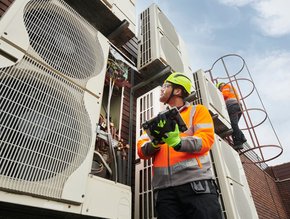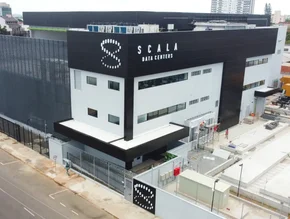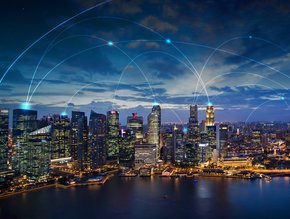Data centre sustainability: energy efficiency reduces cost

Data centres are a part of everyday life with many people unaware of how often they encounter goods and services that run off data centres. To do this, data centres consume vast amounts of power. However, when doing so the heat generated is significant. This is only made worse in hot weather which will become more apparent as climate change continues.
When people use a computer or a smartphone, they rarely think about what it costs in terms of energy. But even something tiny, like adding more names to a list of people copied on an email, will have a real, measurable energy cost.
With cloud now the default way of working for businesses in almost every sector, the amount of energy used by data centres is ever increasing: currently up to 1.5% of global electricity demand, according to the International Energy Agency.
But solutions exist to reduce the impact of our data centres worldwide. And it’s not some exotic new technology - it’s tried-and-tested hardware which already exists, combined with a fresh way of thinking about the environmental impact of data centres.
Part of the problem is that servers have a long lifetime: up to ten years. As new servers come in, older machines may move away from being business-critical to being something that sits at the back of the data centre, doing something occasionally, but still drawing lots of power. Every data centre has machines that no one is quite sure that they are doing - but people are too afraid to switch them off. Businesses need to move beyond this mindset.
Investing in new hardware
As a consumer, you tend to buy a new machine if your PC is going slowly, or as an employee, raising a ticket with IT usually gets it replaced. Servers sitting in a data centre are a very different matter. They keep on working, even when the hardware is inefficient, outdated and power-hungry.
Refreshing your inventory, especially older assets, can quickly pay for itself by reducing the amount of energy that servers draw. In the same way that modern cars have lower emissions than older models, it pays to have the latest hardware when it comes to data centres.
In past decades, many business decision makers imagined that choosing the ‘green’ option was always going to cost money. But what we are seeing today is that the best economic solution also happens to be the most sustainable solution. If you reduce the amount of power your servers consume in the data centre, your power bill goes down at the same time as your CO2 emissions.
Benefits of asset recovery services
Often, if you replace old hardware, you’ll also end up doing the job far more efficiently, with one new box taking the place of 10 or 20 old ones. Updating old hardware doesn’t just cut costs: there’s also a welcome cashflow boost that provides opportunities to improve sustainability to help meet environmental, social and governance (ESG) goals, thanks to asset recovery services.
Every year, the world generates 50 million tonnes of e-waste, enough to cover the island of Manhattan, according to UN statistics. And while Lenovo’s latest research finds that 70% of organisations are already using data to achieve a mix of ESG and financial goals, more needs to be done.
For companies hoping to achieve their ESG goals, an asset recovery service helps in finding the optimal method to dispose of hardware - whether that's recycling, refurbishing, reusing, or scrapping in an environmentally friendly way, such as waste-to-energy disposal. Organisations need clarity and policies around how this is done - equipment can’t be simply thrown into a skip.
Businesses also need to ensure that their asset recovery services work with partners with the highest standards. This removes risk from the customer - there's no danger that the partner will find a loophole to ship the waste abroad and dump it in landfill. This is another important way to safeguard reputation.
Recycling servers in this way generates a lot of ‘wins’. If a company gets a few thousand pounds back for the old hardware, they can buy CO2 offsets for the new hardware - or simply donate to an environmental charity. Of course, carbon offsetting can’t be your only plan for sustainability, but if companies invest in UN-approved CO2 offset projects like reforestation and green power initiatives, it’s a useful tool that can help demonstrate ESG commitments.
Keeping data secure
Protecting customer data has become ever more important for businesses, thanks to privacy regulations such as GDPR. Making sure that data is handled and wiped in the correct manner has moved up the agenda for businesses, so that sensitive information does not fall into the wrong hands. So, in the same way that disposing equipment in a suitable manner is vital, managing and destroying data from these devices in a way that is safe and secure is just as important.
Where once this might have been purely an IT problem, it’s now also a problem for the CFO or other members of the senior leadership team. That's another reason why choosing the right asset recovery service is so crucial; it ensures that sensitive information is correctly handled and destroyed in line with regulations. Particularly for sectors like financial services and the public sector, this is top of the list.
What lies ahead
Data centres will increasingly face regulation and demands for transparency over their energy and water usage. The European Commission is reportedly set to announce a plan to call out and clamp down on data centres’ environmental impact. By 2025, this could see data centres having a ‘label’ which details their energy usage, just like dishwashers and other home appliances do today.
For consumers, buying from sustainable brands is playing an increasing role in purchasing decisions. Across all generations from Baby Boomers to Gen-Z, sustainability is now more important than a brand name when buying a product, according to research. Consumers are increasingly conscious of the ESG credentials of businesses, meaning that organisations cannot afford to have unsustainable practices in their data centres.
Meanwhile, sustainability has become a differentiator in the battle for talent – before people start working at an organisation, they are beginning to evaluate how it treats the environment. That’s a new trend being largely driven by Gen Z, with Bupa research finding that one in three would turn down roles in companies with poor ESG credentials. Sustainability is only going to become more significant for employees, investors and governments, and the importance of data centres and their power consumption will continue to grow.
Going forward, not meeting sustainability targets for a business is going to be almost as bad as not hitting financial targets. This comes in addition to the subsequent effects of climate change itself, with Lenovo’s research finding that 59% of senior executives expect the threats of global warming to have a moderate to severe impact on their business. Yet, although executives recognise these challenges, few have near-term plans in place to address them. Only 33% are taking steps in the next three years to tackle global warming.
With climate change and its impact on the rise, the effect on data centres will become even more noticeable. Last summer many UK data centres had to shut down to cool and unless those working with data centres work together, this problem will get worse. Methods such as recycling, upcycling, and reusing all need to be considered. Sustainability requires ongoing progression and businesses just need to focus on one step at a time to make real change.






